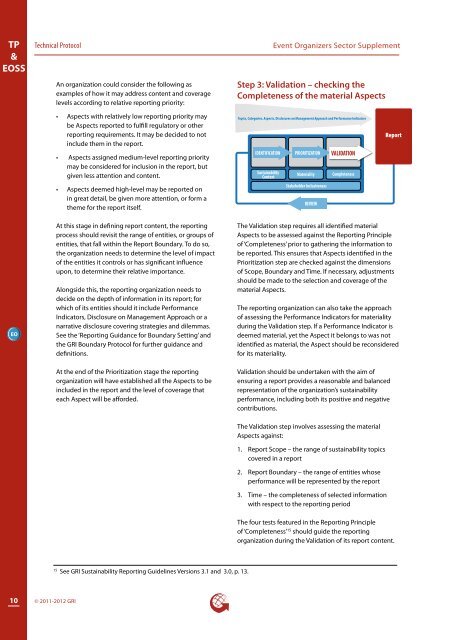Event Organizers Sector Supplement - Global Reporting Initiative
Event Organizers Sector Supplement - Global Reporting Initiative
Event Organizers Sector Supplement - Global Reporting Initiative
You also want an ePaper? Increase the reach of your titles
YUMPU automatically turns print PDFs into web optimized ePapers that Google loves.
TP<br />
&<br />
EOSS<br />
Technical Protocol<br />
An organization could consider the following as<br />
examples of how it may address content and coverage<br />
levels according to relative reporting priority:<br />
<strong>Event</strong> <strong>Organizers</strong> <strong>Sector</strong> <strong>Supplement</strong><br />
Step 3: Validation – checking the<br />
Completeness of the material Aspects<br />
• Aspects with relatively low reporting priority may<br />
be Aspects reported to fulfill regulatory or other<br />
reporting requirements. It may be decided to not<br />
include them in the report.<br />
• Aspects assigned medium-level reporting priority<br />
may be considered for inclusion in the report, but<br />
given less attention and content.<br />
• Aspects deemed high-level may be reported on<br />
in great detail, be given more attention, or form a<br />
theme for the report itself.<br />
Topics, Categories, Aspects, Disclosures on Management Approach and Performance Indicators<br />
IDENTIFICATION<br />
Sustainability<br />
Context<br />
PRIORITIZATION<br />
Materiality<br />
Stakeholder Inclusiveness<br />
REVIEW<br />
VALIDATION<br />
Completeness<br />
Report<br />
EO<br />
At this stage in defining report content, the reporting<br />
process should revisit the range of entities, or groups of<br />
entities, that fall within the Report Boundary. To do so,<br />
the organization needs to determine the level of impact<br />
of the entities it controls or has significant influence<br />
upon, to determine their relative importance.<br />
Alongside this, the reporting organization needs to<br />
decide on the depth of information in its report; for<br />
which of its entities should it include Performance<br />
Indicators, Disclosure on Management Approach or a<br />
narrative disclosure covering strategies and dilemmas.<br />
See the ‘<strong>Reporting</strong> Guidance for Boundary Setting’ and<br />
the GRI Boundary Protocol for further guidance and<br />
definitions.<br />
The Validation step requires all identified material<br />
Aspects to be assessed against the <strong>Reporting</strong> Principle<br />
of ‘Completeness’ prior to gathering the information to<br />
be reported. This ensures that Aspects identified in the<br />
Prioritization step are checked against the dimensions<br />
of Scope, Boundary and Time. If necessary, adjustments<br />
should be made to the selection and coverage of the<br />
material Aspects.<br />
The reporting organization can also take the approach<br />
of assessing the Performance Indicators for materiality<br />
during the Validation step. If a Performance Indicator is<br />
deemed material, yet the Aspect it belongs to was not<br />
identified as material, the Aspect should be reconsidered<br />
for its materiality.<br />
At the end of the Prioritization stage the reporting<br />
organization will have established all the Aspects to be<br />
included in the report and the level of coverage that<br />
each Aspect will be afforded.<br />
Validation should be undertaken with the aim of<br />
ensuring a report provides a reasonable and balanced<br />
representation of the organization’s sustainability<br />
performance, including both its positive and negative<br />
contributions.<br />
The Validation step involves assessing the material<br />
Aspects against:<br />
1. Report Scope – the range of sustainability topics<br />
covered in a report<br />
2. Report Boundary – the range of entities whose<br />
performance will be represented by the report<br />
3. Time – the completeness of selected information<br />
with respect to the reporting period<br />
The four tests featured in the <strong>Reporting</strong> Principle<br />
of ‘Completeness’ 15 should guide the reporting<br />
organization during the Validation of its report content.<br />
15<br />
See GRI Sustainability <strong>Reporting</strong> Guidelines Versions 3.1 and 3.0, p. 13.<br />
10<br />
© 2011-2012 GRI

















